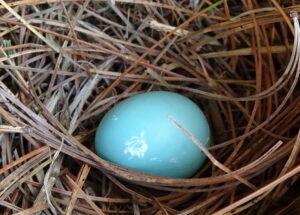 I prowl through budding milkweed and prickly blackberry plants for an hour looking for Monarch eggs and don’t find one. Monarchs are usually here by now, but I’ve only seen three. Last week, I found nine viable eggs—four are still caterpillars and five are now chrysalises, but I haven’t found a new egg for a week. When does persistence become mania? Until I see a flash of orange wings, I’ll search for miracles elsewhere.
I prowl through budding milkweed and prickly blackberry plants for an hour looking for Monarch eggs and don’t find one. Monarchs are usually here by now, but I’ve only seen three. Last week, I found nine viable eggs—four are still caterpillars and five are now chrysalises, but I haven’t found a new egg for a week. When does persistence become mania? Until I see a flash of orange wings, I’ll search for miracles elsewhere.
My first impulse is to go to the forest, but it’s a place of catastrophic destruction this year. As I walk in my most holy place, I see gypsy moth caterpillars devouring oaks, willows, pines, and more in the worst infestation since 1981. The oaks are leafless and look dead. I weep as a rain of caterpillar poop falls from the trees and leaf pieces cover the forest floor. The forester says most can survive this for two years. Maybe. I hope so. Their only natural predator is a fungus activated by moisture. May there be rain.
My predominantly oak forest is hard hit. It hurts to watch bristly two inch long caterpillars crawling over Vic’s cairn, creeping along naked tree branches, and hanging from silk threads everywhere. I visit the forest the way I might visit a sick friend, but I long to leave and search for healing. Today I’ll be a bird woman since all seven bird nesting boxes in open fields have residents.
Before breakfast, a Bluebird take a squirmy bug inside her box while a Hummingbird sips the orange Mandarin Honeysuckle next door. My telescope catches the Bluebird and Hummingbird in one round frame. The four Bluebirds nestlings are ten days old and hungry from dawn to dusk. It’s a long day for the parents who share the work. If I’m lucky, I’ll see the hatchlings fledge next week. If I’m luckier, Monarchs will arrive and the gypsy moth invasion will wind down.
A Tree Swallow shows up at the box that was raided last week. In late morning, I watch her carry beakfuls of grasses into the box to make a new nest. I lay two feathers at her entryway as an offering, one Blue Jay and one Turkey. My heart soars when I open the box later and see both feathers inside. Then she sits on the perch and raises her tail for her mate at least ten times. Sex is gentle and fast with a promise of tiny white eggs in a feathered nest.
Next, I walk downhill to visit the boxes farther from my house and spy three newborn chickadees with four unhatched eggs. Mama doesn’t like my intrusion and makes her warning call. Chick-a-dee-dee-dee with 15 dees to make sure I get the point. I take 10 seconds to glimpse the tiny beings, the size of a dime with pink, embryonic, floppy headed bodies draped over eggs that will hatch tomorrow.
The box next to the chickadees has another bluebird nest with one exquisite egg. The parents are out when I look in, but I glance back as I walk uphill and see her sitting inside the predator guard. He perches on top, flashing his blue wings and orange and white chest. May there be more eggs.
The two Chickadee broods on another trail have flown to the woods with their parents and left behind their moss nests. I watch Wren parents fly in and out of the last box to feed the kids.
Instead of writing, reading, or lamenting Monarch scarcity and devoured trees, I watch birds build nests, lay eggs, and feed their broods. When I’m watching at the right moment, I see the fledgling’s first flight. These are my Summer Solstice miracles.
***
What do you do when something disappointing happens and there’s nothing you can do to change the problem–as in the gypsy moth caterpillar infestation or the heat and drought in the west? When Vic had cancer, I learned I could always find one positive thing at the worst of times–a nurse’s tenderness, a ray of sunshine, Vic’s smile when I brought him a decaf cappuccino with soy milk from the coffee shop in the hospital lobby. This looking for one small positive thing is a practice that helps me balance bad vertigo days, bad news, or anything upsetting.
For other posts about Monarchs, see Dancing with Monarchs, Defying Despair. For a post about the love of my forest see For the Love of Trees.
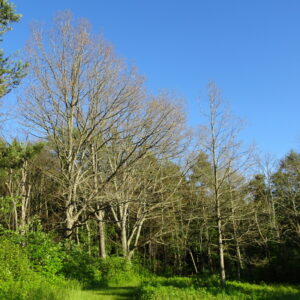

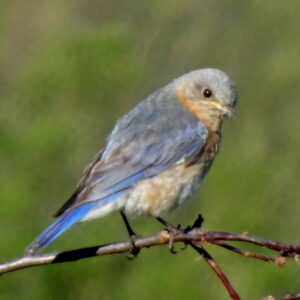


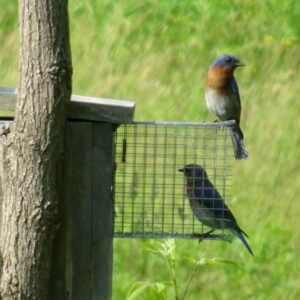
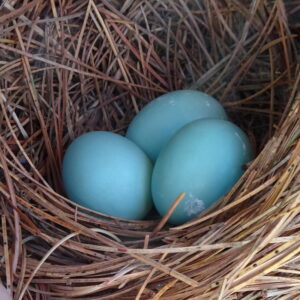
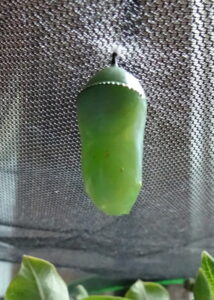
Well, it’s no good, if the Monarchs won’t go to Mama, her friend will bring them to her in the only way a poet can, by pen … so look out for those beautiful winged tigers in the next few days because a poem will surely be winging its way over to you this week! I have no idea how’ll it go but how exciting! Yes, yes, yes, I needed a reason to pick up my pen and since “mothering” is so much on my mind of late, the Monarchs must come to Mama! Hush, listen, even the flowers are laughing again as Kairos, the right time, is almost upon us.
Oh, how you brighten up my day Elaine with your wonderful photos and updates on all your nests and fledglings. Bluebirds, Hummingbirds, Tree Swallows, Chickadees are all bird species we do not see in the UK (nor those beautiful Monarchs!) so I’m always happy when they visit your blog … especially today, at the still-point of this turning world.
What do I do when something disappointing happens or disappears? Hmm, today I’m realising that there are many ways to bring back what is missing and at the same time give away what’s missing too. Thank you so much for helping me find that one positive thing today my dear friend as I reach to pick up my pen! Love and light, Deborah.
You’re right. It’s no good! This morning I saw a beautiful orange butterfly on my morning walk and it looked just like a Monarch, but as I got closer I saw a line of black through the wing that identified it as a Viceroy, a Monarch look-alike. There are a few Monarch look-alikes that don’t do the big migration, but their color protects them from predators that think they would taste bitter like a Monarch. I enjoyed the Viceroy’s beauty as it warmed its wings in the morning sun. It looked newly hatched. I’m enjoying the 6 chrysalises and 4 caterpillars in my Monarch nursery and hope most or some of them are female because they have lots of egg laying to do. I watch over them like a neurotic mother.
Summer Solstice can be an odd time of year here. I see where the sun sets on the western horizon and know it’s as far north as it will go, but the weather is cool and wet. The wet is fortunate because my forest has been stripped nearly bare by gypsy moth caterpillars, but the caterpillars now have a natural virus that only shows up in a wet season. They’re dying and tiny leaves are sprouting on those trees. If the caterpillars can’t reproduce, the forest will be saved from another devastating year. In my nearly 50 years on this land, I’ve never seen anything like this. It’s a reminder of impermanence.
I almost always turn to nature or writing for dealing with disappointment or hardship. I can hardly wait for your butterfly poem, because these Monarchs carry my soul/psyche projection. I’m writing about them–the wanting of them, the plants waiting for them, the small group in my butterfly nursery, ones that may still arrive. Their miraculous transformations are awe inspiring. Love to you as you pick up your pen and maybe I’ll see you on Twitter sometime. Like these Monarchs, I never know where I’ll find you. May you be surrounded by joy and beauty, dear friend.
Oh, how clever those beautiful Viceroys are (I’ve just googled them)! I would never be able to tell the difference between them and Monarchs. Twin souls of the Psyche for sure! And there it is in your reply that “mother” word again, running across the page.
Tsk! I don’t know much about gypsy moth infestations but it sounds awful, absolutely devastating for trees. I sincerely hope that your forest recovers in the next year or two and the incessant raining of caterpillar poop stops!
That the Monarchs carry your soul fills my heart with joy!
I’ve saved the best till last. Check your email for “Mama Monarch” should’ve arrived by now. Love and light, Deborah.
Your poem arrived, Deborah. I’m savoring and sharing it. The gypsy moth invasion is upsetting, but it seems to be on the wane. Imagine that beautiful oak you love covered with long furry caterpillars and not one leaf. There is a natural fungus and a virus in the soil that kills them in wet weather and that seems to be happening now. I’m hopeful the worst is over and see tiny leaves on some trees that looked dead. A forest can handle a few years of this invasion without killing the deciduous trees, but the evergreens are more vulnerable and can’t regrow needles. These caterpillars eat almost anything and strip a forest clean. Yikes! I believe in life, but not their life. At least the caterpillar poop rain has stopped, but it’s odd to walk in a mature forest on Summer Solstice with an empty tree canopy. Very odd. Foresters reassure me they will survive. I’m trying to stay hopeful.
I saw one Monarch this morning, moving fast, but flitting through the milkweed. Your poem is calling them in. I sent you my Active Imagination conversation with the Monarch that wasn’t interested in lingering. There are a few other Monarch imposters here. Their Monarch-like color and marking protects them from predators. Nature is brilliant. Love and gratitude to you. That poem deserves a special place and I’m not sure where–but maybe in whatever it is that I’m writing about Monarchs. May more arrive! The milkweed waits for them.
Aww, thank you so much Elaine for your beautiful, kind-hearted words! I’m eagerly looking forward to your next Monarch post now. Yes, I loved your active imagination with the Monarch this morning. And btw the special place for the poem is in your heart. No bells, no whistles needed Mama Monarch! x
I’m saving the Monarch posts as part of something larger (potentially, maybe, possibly), but I’m sure a few photos will appear. I saw 5 Monarchs in the field yesterday and released another from my butterfly nursery–and this morning I found 2 eggs in about 5 minutes. And I’m writing about them and your poem. You’re an inspiration.
Elaine, I like how your post pivots from Monarch scarcity and devoured trees to bird births and fledglings’ first flights. People like us with the impulse to nurture take loss and suffering harder than most, I believe. Your attention to detail is amazing. You observe . . . and you write things down.
At the end, you asked what do you do when something disappointing happens? As a matter of fact, I was doing research in my journal this afternoon to find info another author inquired about. In the process, I paged through other parts of a previous journal and found a 2-page spread, the left side labeled Blessings and the right, Concerns. Of course, the Blessings numbered 15 and the negative side, much less. For some reason, quantifying things makes it clear that my blessings outnumber my disappointments. In that there is healing—gratitude begets optimism.
Thanks for another blog post that provides a window into your world, Elaine, and challenges me to appreciate mine too! 🙂
Marian, my son said I was worrying about things not in my control when I wandered throughout the forest yesterday to take in the scope of the devastation. I explained that I was witnessing not worrying–and they aren’t the same. Witnessing is more like prayer. In the 1970s, Quakers taught me the power of witnessing when we were having quiet protests against the war in Vietnam. I wanted to see what the trees are going through. And something good came of it for me because besides trees as naked of leaves as they are in winter, I saw that recent wet weather has brought out a natural fungus and virus specific to gypsy moth caterpillars and the caterpillars are dying (before laying eggs for next season–hurrah!) and the trees will have time to sprout new smaller leaves. I want to love all creation, but it’s hard to love a gypsy moth after seeing what they’ve done to the trees. Maybe I can love them for reminding me to appreciate the forest. The gypsy moth is like a Biblical plague.
I love your journal entry approach. I like keeping track of all the blessings (there are so many) and holding a balance. I want to see the hard things of the world and there’s plenty of that, but also the beauty and gifts. Not everyone is so fortunate. So there comes the gratitude. Thanks for your thoughtful comment, Marian.
🙂
O Elaine, this is so beautiful, creation and destruction in one fell swoop. I lament for your forest, but I think of my husband’s annoyance at whatever was eating his tomatoes and leaving behind grungy half eaten ones. Just yesterday he came upstairs showing off 7 perfect tomatoes, delicious to eat. Why these thrived, who knows. Maybe the gypsy moths are just having their fill before the rains come? And of course your FB post of tossing those amaryllis into the garbage and UP they came! Mine also bloom when I think all is lost.
Keep on seeking miracles. I hope the monarchs come soon.
Disappointment is I think one of the saddest words in the world. It says so much of what isn’t or wasn’t. For the moment I can’t think of an instance of disappointment, except a time long ago when I had to cancel a visit to a disabled person on account of the roads being blocked. Richard said to me, I’m disappointed. Somehow that cut me to the core.
Susan, we had lots of rain last week over many days, and the natural virus and fungus that kills the caterpillars arrived before they laid eggs for next season. Hurrah!! Some might survive, but most don’t and the diseases that kill them are on the march (and don’t harm anything else). A few critters eat tomatoes here from slugs to hornworms to rodents and I resent all of them. Your husband was attached to those tomatoes. I’d use the word disappointment for his response.
I have 10 Monarchs in chrysalis or large caterpillars in my butterfly nursery. They arrived very early and just a few, but I’ll release those when they’re ready to go. The milkweed patches are waiting and maybe by then there will be more. We had a devastating freeze in the major migration pathway in Texas in February and then a cold spring with lots of north wind. Monarchs need a wind from the south to get here, but they keep spreading around as they search for good milkweed patches so there will likely be more. I want to send out a text message or an email to them to come here.
You encourage me to pull apart the word dis-appointed. To be appointed means we’re chosen for something or been given a specific role–and dis negates that appointment. That feels like the true meaning, although I also use it to refer to my government, my hearing, and all sorts of things where life isn’t turning out the way I wanted. There’s no doubt I have too many expectations and I feel like a constant major life lesson for me is to witness without expecting a determined outcome. Then there would not be disappointment. I’m practicing, but far from reaching that goal. Best to you as the days grow slowly longer in your world.
I love following your observation–how many times the bluebird lifts her tail, how many dee-dee-dees from Mama Chickadee, the amazing photo of the broods–you create abundance for us.
Thank you so much.
Thank you, Harriet. I’ve become more visual with less reliance on sound but I can hear bird calls and I counted those dee-dee-dees because I’d recently read that the more dees, the more alarmed they are. They were alarmed. The chickadee babies are so tiny. I’ll share a photo of them today. The bluebird nest downhill was raided by a wren who left a calling card by stuffing the nesting box with sticks. I thought that box was too close to the forest for bluebirds, so this winter I’ll have my helper Matt put up a few bluebird boxes in the middle of a field far away from the boxes near the house and far from trees where the wrens hang out. I have 3 more boxes and predator guards and know where they need to be placed. Damn those wrens! The bluebirds near the house fledged, so four made it this season and there could be a second nesting. Three broods of chickadees flew, so that’s about 20 birds. I’ll need lots of seed for them this winter. Love to you.
I love your writings Elaine. of course you and I talked a bit in person last week about the awful destruction of the gypsy moths. I am sorry to hear about the lack of monarch eggs. I will pray that there are more to be found. These changes and others in nature, make me sad and a bit scared. I feel helpless. I do my part to make a difference but sometimes it seems futile. You asked what we do when things disappoint us. I allow myself to bemoan whatever it is that’s disappointing me, but then I ask myself, “Ok, but what’s good?” It defiantly helps to focus on the positive; even if the positive feels small compared to the disappointment. Eventually if I focus on the positive long enough, I am filled with gratitude and peace and when I am in that state of mind, then I am able to better handle the disappointment, or focus on a solution.
Hope to see you soon Elaine. Love, Wendy
Thank you, Wendy. It’s quite a balance between the gypsy moth invasion and the lack of Monarchs, but I saw one Monarch this morning. One is good and another is about to eclose in my backyard nursery. Maybe they’ll find each other in the field. I’m also frightened by these natural (and manmade) catastrophes and feel helpless, but gypsy moths have been around for a while. I hope my trees are healthy enough to survive this. I’ve done all I can to keep the forest healthy.
I have a similar exercise and way of dealing with disappointment. I let myself feel the sadness and then search for the opposite side of life. This was a helpful daily exercise when Vic was sick. There was so much grief and destruction happening to his body, but there was always something beautiful and something to love, even if it was a muffin from the coffee bar at the hospital, a ray of sunlight, or a nurse’s gentle touch. Focusing on one small thing helped me through many rough times–and brought me back to gratitude and acceptance if there is no solution. I hope we’ll walk again soon, Wendy. Some of the trees are putting on tiny leaves and they will grow, but the trails feel hopeful again. Love to you.
It’s surely a bad New, dear Elaine. I wonder why as we have seen these last years that nature could take a rest because of the Corona! Actually, I saw here a lot of butterfly and it was unusual for me somehow. Maybe you should wait a little, they will come again for sure. At least, the birds make their continuation. Thank you for the beautiful pictures and your wonderful discoveries. Stay safe, my dear friend. Peace and Love ♥️
The gypsy moths will end their cycle (the last big invasion in this part of the country was 1981) and the butterflies will return (I hope). The Monarchs have had extra migration challenges this year, but nature is resilient. The nesting birds have been beautiful to watch. As I write this, a hummingbird sips at my back porch feeder. I feed them so they nourish me with their beauty. Returning Peace and love to you, my friend.
Thank goodness for rain! Now you’ll get your forest back. I wish rain carried a virus for the woolly adelgid, the aphid-like insects that are destroying our beautiful old eastern hemlocks. It’s rained a lot here, but that doesn’t affect them. We’ve inoculated the hemlocks closest to our house twice and they’re still hanging on, but looking sadder each year. We’ll have to cut them soon before they rot through and fall, destroying anything in their path. We’ve lost dozens more over the last 15 years. It’s so sad because they make the most beautiful, sheltering canopies under which many shade-loving flowering plants thrive.
I’ve handled my disappointment about this by “recycling” many of them. Some were made into benches that dot the property. Others were cut into planks and dried. When they were ready, our wonderful neighbor created a gorgeous 10 foot long table that now sits on our covered and screened porch. Still others were cut about three feet above the ground and hollowed out enough to contain potting soil and boxwood bushes. Their roots continue to hold the earth together and prevent erosion.
And the cycles go on. Knowing that makes me feel better too.
Thank you for another beautiful post.
Jeanie, the rain set the gypsy moths back (after the trees were striped of leaves), but it’s dry again and I see more of them clustering to go through the metamorphosis to become egg laying moths. Sigh…. Like the adelgid, there’s nothing that works in the long run. I have only one large old hemlock in my forest (and many just a few feet high), but a short walk uphill brings me to a ravine in the National Forest with a lovely stream full of small waterfalls. Hemlock is the predominant tree on the Ravine Trail. I used to walk to the hemlocks most days and lie in a circle of hemlocks and look up at the sky. Maybe 30 years ago, I dreamed the hemlocks with their graceful branches were goddesses. They’re dying here, too. Since they aren’t on my land, I can’t do anything to help, but the forest service is trying. My one old hemlock and many pines probably won’t recover from having all the needles eaten by gypsy moths. The cycles go on and some Monarchs have returned, but we’re in a tenuous spot with Nature. She isn’t happy with us and I don’t blame her. I hope your summer is beautiful, even if poignant.
I find myself mesmerized by your words and photos, Elaine. And I delight in the idea of you sending out a text message or an email to call the monarchs to you. I am sure you are doing that psychically, and Deborah’s poem may help!
We, too, have gypsy moth destruction each year, which is the worst in August when there is the least amount of rain, but nothing (as long as we have lived here) as devastating as what you are describing. I love your response of turning from what is disappointing to searching for small miracles.
The heat wave we experienced on the west coast recently was hard on so many beings (plant and animal, including myself), and as I find myself recovering from the setback in my illness and seeing what may not recover in nature, it helps to follow your lead of focusing on something beautiful and something to love. Today I am watching the barn swallows, who have just finished building an exquisite nest on the inside corner of our porch made from from the mud in our nearby duck pond. I love not only watching them but also listening to their frequent chattering, which reminds me of all the exciting things happening in the world. Thank you for the inspiration just when I needed it.
Deborah wrote a beautiful poem, Anne. You can see it at her website if you haven’t already found it: http://theliberatedsheep.com/mama-monarch/
The forest was devastated, stripped bare, but I’m assured that most trees will recover if we’re lucky and the caterpillars get diseased. We’re lucky! While others complained about 5 days of on-and-off rain and mist, I rejoiced because the caterpillars got a deadly fungus on top of already having a virus. Some still made pupae, so I’m not sure if those are viable or also affected by the fungus. When I see them, I spray them with organic horticultural spray. I’ll find out in the winter, but now I see only a few moths in the forest–and I’m a ruthless killer of those moths. The females are slow and low on the bare trees, so easy to spot. I only saw 2 yesterday, so I’ll look for them again today–after I search for Monarch eggs. Some trees are producing tiny leaves now but at least a few pine trees are bare and probably won’t survive since they can’t regrow needles. I’m grateful we haven’t had a hot dry summer like last year since the fungus thrives with wet.
We used to have barn swallows in the old open barn and I loved their communal behavior and watching them fly. I’ll never forget watching a flying lesson with about a dozen little ones on the roof of the barn. They all made it. That original barn was collapsing and beyond repair, so it was replaced by a new barn that keeps barn swallows nesting elsewhere. Barn swallows are beautiful, but I remember the mess they made on Vic’s tractor, so I hope you have a tarp to put under the nest. Tree Swallows are their neater cavity-nesting cousins. I still have one last family in a nesting box this season. I watch the parents go in and out taking in the food and carrying out the waste. It’s a wonder I get anything done besides searching for insects (good ones and destructive invaders) and watching birds. I found a robin’s nest in my magnolia tree with twins about to fledge. Nature is full of life and excitement this time of year, and I’m cheering for those new pale green oak leaves. Love to you, Anne.
When I started to clean my nesting box, there was not nesting material just what seemed to be black earth. what happened
I don’t know, Mary. I’d guess mites, but you could contact Audubon Society or other bird experts. Where I live, there’s the Lab of Ornithology at Cornell University. I’ve mever had this problem, but read that mites can turn nest residue into soil. This site talks about mites, but I don’t know if that’s your problem. https://nestwatch.org/connect/blog/the-life-and-times-of-mites/
if I don’t clean out the boxes using a weak solution of 1 part bleach to 20 parts water between and after nesting followed by drying the box out so all bleach evaporates, in sunlight if possible, winter mice move in and make nests with milkweed fluff. Adorable, but not for birds in the spring. I clean boxes carefully before nesting and between nesting to prevent disease. I have trouble with predators, probably raccoons, so have predator guards on all the bird houses now. I also have side entry boxes which are easy to open and thoroughly clean with a brush while I wear rubber gloves. You can also use a dilute organic cleaner like Dr. Bronner’s if all is well rinsed at the end of the process. I hope you find expert advice.